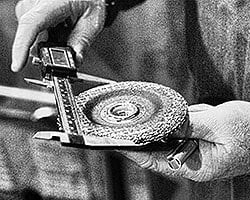Why It’s Important To Measure Grinding Efficiency in Your Operation
By David Jescovitch, abrasives specialist manager, Weiler Abrasive
Does your operation have issues with running overtime on production or falling behind on deliverables? Perhaps labor challenges are causing issues with bottlenecks or slowdowns.
All these factors can be affected by the grinding efficiency in your metal fabrication operation. When grinding isn’t being done as efficiently as possible, it can be a traffic jam that slows down your entire production process.
Think about what even a 10% improvement in grinding efficiency could mean for the overall operation. Having more labor hours could help you eliminate overtime or improve throughput — almost like hiring another employee.
Working with an expert can help determine exactly how much time and money your operation spends on grinding, finishing and cleaning — which in turn can help you find improvements that save time and reduce costs.
How does grinding affect efficiency?
 In many operations, grinding efficiency is often overlooked, especially when there are no obvious problems with it. But inefficiencies in grinding can result in delays or time lost across the rest of the production facility.
In many operations, grinding efficiency is often overlooked, especially when there are no obvious problems with it. But inefficiencies in grinding can result in delays or time lost across the rest of the production facility.
Some of the most common mistakes that can reduce grinding efficiency include:
-
Choosing the wrong abrasive for the job: Sometimes, operations have been using the same grinding wheel for years without looking at data or considering other options. But using the wrong abrasive for the work being done can result in less effective performance and shortened abrasive life — both of which add more labor time to complete the work and more frequent product changeover. This added time may also cause you to miss quality or productivity goals and increase operator fatigue — and the risk for injury.
-
Using a less expensive, low-amp grinder: Choosing the right abrasive is key, but a product can only work as well as the tool it’s used on. A low-amperage grinder may not have enough power to push a grinding wheel that has a hard bond, for example. This leads to wheel loading and poor performance (reduced efficiency), and operators may throw away the wheel sooner (increased consumable costs).
- Using the wheel incorrectly: How the operator uses the grinding wheel also plays a role in efficiency. Using too much pressure can damage the workpiece and increase scrap, which significantly increases production time and costs. Excessive pressure can also increase operator fatigue and the potential for injury. The pressure being used often ties back to the product choice. If the wrong abrasive is chosen, the operator may push harder to get better performance. Excessive wheel vibration can occur when the product is being used incorrectly or the wrong product is chosen. Wheel vibration also adds to operator fatigue, which can impact employee turnover and retention.
Measuring grinding efficiency
 What is the value of grinding in your facility right now? Many facilities don’t know or have never put a dollar figure or time figure on it. Longer product life that results in reduced grinding wheel costs is nice. However, a reduction in labor thanks to increased efficiency can have a much bigger impact, since labor is the largest cost in any grinding operation. Labor time saved translates into greater productivity — which is paramount if your goal is to get more product out the door, even with fewer people.
What is the value of grinding in your facility right now? Many facilities don’t know or have never put a dollar figure or time figure on it. Longer product life that results in reduced grinding wheel costs is nice. However, a reduction in labor thanks to increased efficiency can have a much bigger impact, since labor is the largest cost in any grinding operation. Labor time saved translates into greater productivity — which is paramount if your goal is to get more product out the door, even with fewer people.
Working with experts to analyze and determine abrasive costs and efficiency can help operations understand exactly how much their grinding process costs and where gains can be found.
While it’s easy to purchase products based solely on price, that potentially compromises safety, performance and productivity. To find real cost savings, facilities must test and evaluate products to select abrasives that will allow them to reduce cycle times, save dollars and guarantee better results.
The Weiler Consumable Productivity Program (WCP) collects hard data around how abrasives are used, how long they last and how productive they are. The program looks at the entire process — everything from your abrasives spend and labor costs to the time spent on grinding and the material removal rate — and effectively compares several products to determine the best product for an application.
Choosing the right abrasive products
Evaluating the efficiency of the grinding operation and then making a change to the abrasive product being used can make a significant difference. This change could involve a switch in the type of product being used — moving from a grinding wheel to a flap disc, for example — or to the abrasive grains being used, such as switching from zirconia alumina to ceramic.
If a grinding wheel has always been used, changing to a flap disc may provide faster cutting in some applications, and a resin fiber disc may offer even more speed and faster cutting. But a resin fiber disc won’t last nearly as long as a grinding wheel, so the right choice depends on the goals of the operation. When it comes to abrasive grain retention, a softer bond breaks down faster but tends to be preferred by operators since it feels smoother and more comfortable to use.
It’s important to look at the entire application — including before and after the grinding process — to choose the right abrasive product.
Optimizing grinding performance
 Once the abrasive is chosen, how can operations maximize grinding performance to ensure they're getting the efficiencies they planned on? Following best practices and using proper technique can help optimize results. Here are some tips to keep in mind:
Once the abrasive is chosen, how can operations maximize grinding performance to ensure they're getting the efficiencies they planned on? Following best practices and using proper technique can help optimize results. Here are some tips to keep in mind:
- Start with a backstroke: Always start to grind with a backstroke before pushing forward. This helps break in the wheel and reduces the chance of gouging the base material or getting wheel kick-back that can result in operator injury.
- Don’t exceed speed or size recommendations: The speed rating of the abrasive product should always meet or exceed the speed rating of the tool it is used on. The wheel size should also match the size of the tool.
- Use appropriate pressure: Proper pressure is critical with any abrasive product since heat is the enemy of an abrasive. Using more pressure than necessary produces more heat, which breaks down the wheel faster and potentially causes product loading.
- Watch your orientation: Holding a type 27 grinding wheel at a higher angle, such as 35 degrees, will result in a faster cut but this angle also reduces wheel life. Grinding at an orientation of 10 degrees to the workpiece helps extend wheel life.
- Keep the wheel in motion: Don’t dwell in one spot too long, which can cause heat to build up. Move the wheel back and forth, almost like a sawing motion, with two hands on the grinder. Also, when the operator engages their hips and lower body in this motion, it helps release stress in the neck, shoulders and arms to avoid injury.
- Choose the right abrasive for the material: If you’re grinding aluminum, a wheel that isn’t designed specifically for that material will load up quickly and reduce performance. Instead, buy an abrasive product designed for aluminum.
- Use products as designed: If you are grinding and cutting, be aware that some wheels are designed to do both tasks while others are not. Look for markings on the wheel that designate if it’s for grinding only or can be used for cutting and grinding. It’s hazardous to use a wheel for a job it isn’t designed to do.
It’s important to always read the recommendations and safety information for any grinding wheel to get the best results. Also keep the tool guards in place and use them properly to enhance operator safety.
Improving grinding wheel efficiency
Inefficiency in the grinding operation can be a much bigger expense than many operations realize. Analyzing how much time and money your grinding products and process cost can help you choose the right solutions for your application. In addition, training operators to use abrasive tools to their full potential is critical to overall efficiency and safety.
David Jescovitch, Abrasives Specialist Manager,

